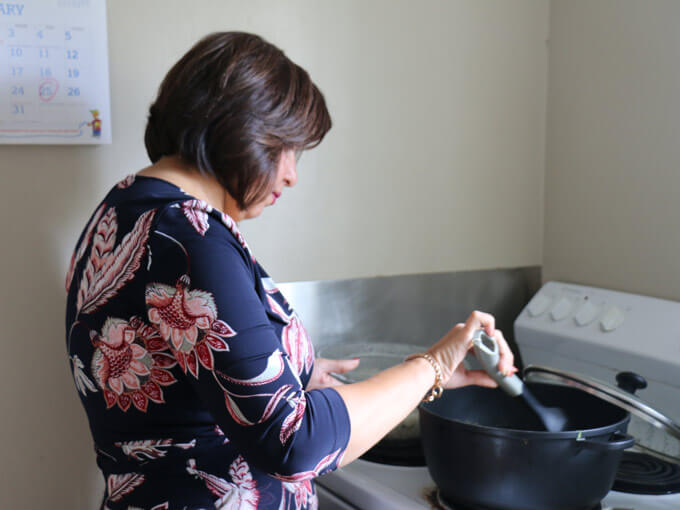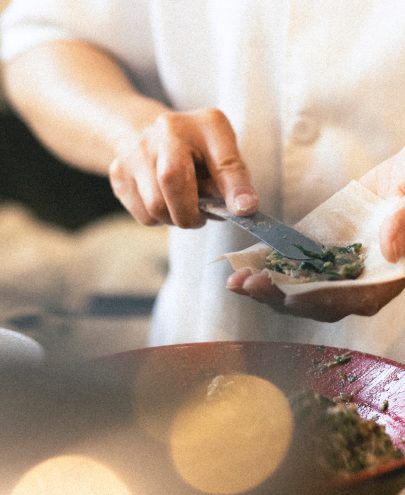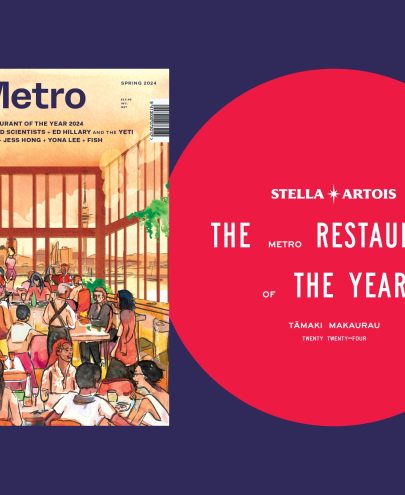Feb 12, 2019 What's On
Our Stories on a Plate brings women of all cultural backgrounds together.
Sikka is a teacher at Henderson Primary School but spreads herself across the community as a volunteer, mentoring high school girls and teaching yoga classes to refugee women on Fridays. In between, she’s organising workshops to empower refugee and migrant women as the founder of Our Stories on Plate, an initiative to address the realities of displacement through community connections.
Some workshops it’s food, sometimes not. Once, it was a lesson in how to make ‘ei katu, a Cook Islands flower crown, proposed by a mother of one of Sikka’s schoolkids. Another time, a masterclass in making poi. Sikka makes it clear it takes the generosity of a village to make these happen – and coins from her own pocket. Last year, she was recognised through the inaugural Auckland Foundation Women’s Fund award, but the hustle for financial backing never ends.
As we sit cross-legged on the floor around plates of food, she tells me breaking bread together is the gateway to understanding. Food keeps you connected to your roots, and, through sharing, is a way to narrate and deconstruct your past. “The things these women have gone through… It’s healing, it’s an escape.”
There is a fierce sincerity to platitudes we’re used to hearing: “Every day when I wake up, I think ‘How can I make a difference to others?’ And when I ask if food can truly build bridges between cultures, the answer is an emphatic yes. Auckland is changing,” she says. “It is. It’s changing.”
Her latest project takes place over a weekend as part of the Auckland Fringe Festival, two community workshops where there’s an open invitation for women of all backgrounds to pull up a chair and tell their stories over some kai. It’s also free: bring a plate of food to share and come armed witarbitraryh a recipe in mind. Pen in hand, participants can etch their histories onto a template before putting them through a specialised printer to make into placemats. Then, ferry them home; it could soon become your go-to dinner-party icebreaker.
Our Stories on Plate workshops will take place on Saturday 23-24 Feb, 11am-3pm.
In the spirit of sharing, Renu tells us how to make the chicken dopiaza and dhal pictured.
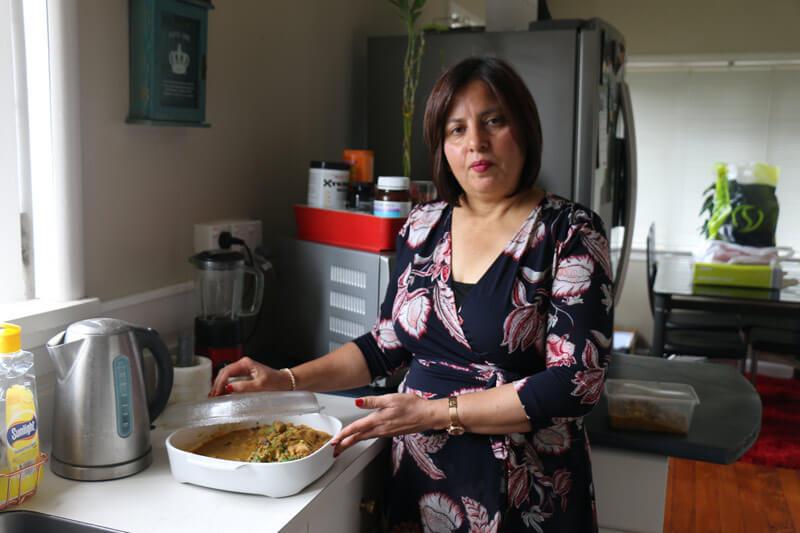
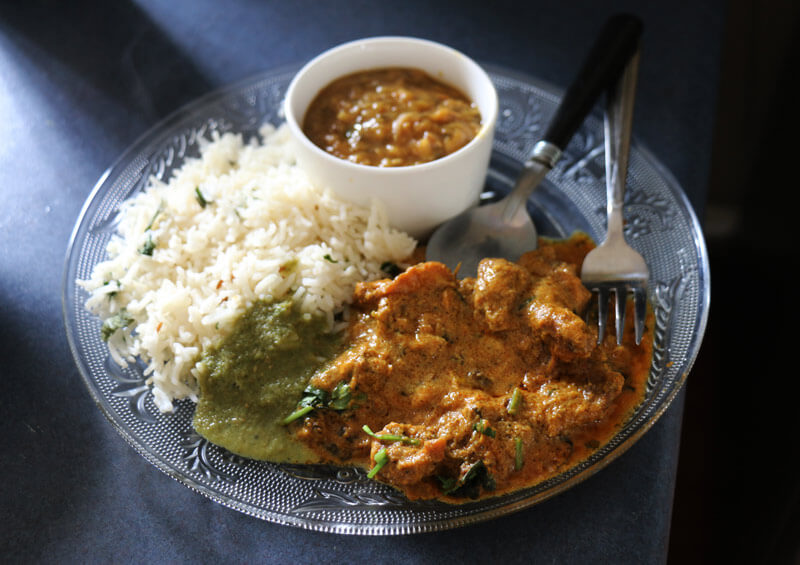
Recipe: Chicken Dopiaza
Note from Renu: This is a classic Indian dish of ‘Do’ or two ‘piaza’ onions – two onions or double onions. It has a distinctively thick yoghurt sauce packing a medium level of heat. It’s simply delicious.
Serve with basmati rice, naan bread or roti.
Ingredients:
4 medium onions peeled, 2 chopped and 2 sliced
8 chicken thighs, skinned & chopped
3cm ginger, grated
3 cloves of garlic, finely chopped
1 tbsp of vegetable oil for cooking
1 tbsp coriander seeds, crushed
1 tbsp cumin seeds, crushed
1 heaped tsp ground turmeric
½ tbsp chilli powder
4 tbsp plain yoghurt
2 tomatoes, finely chopped
1 tsp salt
½ tbsp garam masala
Handful of coriander, chopped
Method:
- Place the chopped onions, ginger and garlic into a blender and blend to a paste then set this aside.
- In a pan heat the oil, put in the sliced onions and fry until they are slightly crispy and reddish-brown. Remove the onions and set aside.
- Remove the pan from the heat and add the blended onion paste – be careful, this will splutter.
- Place the pan back onto the heat and keep stirring the paste for 3 minutes until it has turned golden brown.
- Add in the coriander, cumin, turmeric and chilli powder and stir.
- Then gently start to stir in 1 tbsp of yoghurt until it’s mixed well into the sauce. Do the same with remaining yoghurt, 1 tbsp at a time.
- Add the chicken and stir for a minute until well coated with the yoghurt mixture.
- Add the tomatoes and salt. Stir until mixed thoroughly and bring to a simmer.
- Cover the pan, reduce the heat to low and cook for 20 minutes.
- Sprinkle in the garam masala and the fried onions.
- Mix and leave to cook, uncovered, for a few minutes until the sauce thickens.
- Add fresh coriander to serve.
Dhal
Ingredients:
100g split chickpeas (chana)
100g split green beans, washed and checked for stones
1L water
1 tsp salt
Masala:
1 tbsp vegetable oil
1 small onion
1 clove garlic, chopped
½ tin or 200g tomatoes
1 tsp ginger, grated
1 chilli, finely chopped
1 tsp turmeric
½ tsp salt
1 tsp garam masala
Handful of fresh coriander, chopped
Method:
Put the lentils in the pressure cooker and add 1L of cold water.
Add 1 tsp of salt put the lid on the pan and bring to the boil. Let the pan come to temperature and whistle once, then reduce the heat and leave to simmer for 30 minutes. After this time remove from the heat and leave the pan to cool – DO NOT REMOVE THE LID.
Masala
Meanwhile in a medium sized pan heat oil and add the onion and garlic, fry until lightly browned.
Reduce heat and add tomatoes, ginger, chilli, turmeric and ½ tsp of salt. Continue to cook so the tomatoes and onion have melted together to create a thick paste.
Once the pressure cooker has cooled and the pressure has been released open the lid. Check the lentils are cooked by squeezing them between your fingers. If they are soft they are ready.
Add the cooked dhal to the masala and stir, leave to cook for about 5 minutes.
Stir in the garam masala and throw in the coriander to serve it with basmati rice or roti.
Follow Metro on Twitter, Facebook, Instagram and sign up to the weekly email for more food and culture news.

